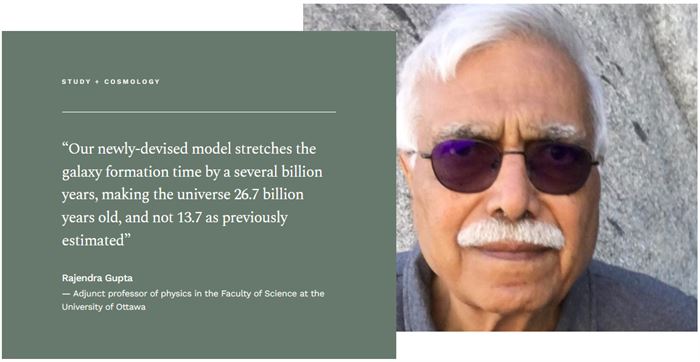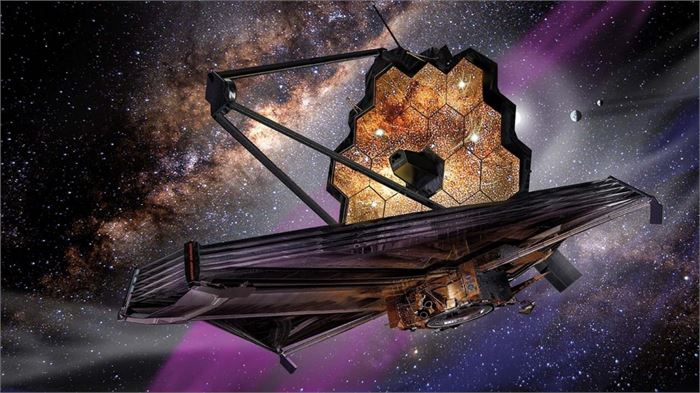빅뱅은 138억 년 전이 아니라 267억 년 전에 시작됐다는 주장이 나왔다. 즉, 우주의 나이는 우리의 기존 생각보다 거의 두 배나 많다는 것이다.
오타와 대학 겸임 교수인 라젠드라 굽타(Rajendra Gupta)는 빅뱅이 놀랍게도 267억 년 전에 일어났을 수 있다는 것을 발견했다. 그는 기존의 팽창하는 우주 이론을 ‘피곤한 빛 가설’과 결합함으로써 이 같은 결론에 도달했다.
 굽타 교수
굽타 교수
굽타의 모델은 최근 제임스 웹 우주망원경(JWST)의 발견으로 뜨거운 감자가 된 '불가능한 초기 은하 문제'를 해결해준다. 최근 JWST가 발견한 가장 어린 은하는 빅뱅 이후 불과 3억 2,500만 년 만에 고도로 진화한 은하로 현재의 우주론으로는 설명할 수 없다.
우주론자들은 처음에 어떻게 우주의 나이를 138억 년으로 계산했을까?
 제임스 웹 우주망원경
제임스 웹 우주망원경
우주의 나이에 대한 현재 추정치는 우주마이크로파배경복사(CMB)의 관측과 허블의 법칙을 통한 우주 팽창 측정을 기반으로 한다.
CMB는 우주가 탄생한 지 불과 300,000년 전으로 거슬러 올라가는 빅뱅의 유물 복사선(radiation)이다. 그것은 우주에 스며들어 있으며 관측 가능한 우주의 가장 초기 복사선이다.
허블의 법칙은 1920년대 천문학자 에드윈 허블에 의해 확립되었다. 그것은 은하의 거리와 속도를 연관시키고 허블 상수라고 하는 우주의 팽창 속도를 결정하는 데 도움을 준다. 이 패창을 역으로 외삽하면 빅뱅의 시간을 추정할 수 있다.
왕립천문학회의 월간 고지에 발표된 논문에 설명된 굽타의 새로운 모델은 완전히 다른 접근 방식을 취한다.
"피곤한 빛"으로 알려진 이론(1929년 물리학자 Fritz Zwicky가 처음 제안함)은 먼 은하에서 오는 빛의 적색편이를 설명하기 위해 채택되었다. 현재 우주론에서 적색편이는 우주 팽창으로 인해 빛의 파장이 늘어나는 현상이다.
피곤한 빛 이론은 광자가 우주 거리에 걸쳐 점차적으로 에너지를 잃는다고 제안한다. 더 적은 에너지는 더 낮은 주파수와 더 긴 파장을 의미하며 밝고 멀리 있는 물체의 스펙트럼을 이동시킨다.
굽타는 "피곤한 빛 가설을 팽창하는 우주와 공존하도록 허용함으로써 적색편이를 순전히 팽창에 의한 것이 아니라 하이브리드 현상으로 재해석하는 것이 가능해진다"고 말했다.
그는 두 가지 확장 우주 모델로 시작한다. 하나는 우주의 평탄도에 대한 표준 가정을 기반으로 하고 다른 하나는 결합상수로 알려진 것과 관련된 약간의 조정을 도입한다.
Gupta가 도입하는 새로운 결합상수는 시간에 독립적인 기존 결합상수와 달리 시간이 지남에 따라 변한다. 그것은 우주의 초기 은하의 존재를 수억 년에서 수십억 년으로 확장하는 데 기여하고, 우주의 나이를 거의 270억 년일 수 있다는 결론을 내리는 데 도움을 준다.
결합상수는 근접한 두 양성자의 전자기장이 특정 방식으로 서로의 행동에 영향을 미치는 방식과 같은 입자 사이의 힘의 상호작용을 설명한다.
모든 힘에는 에너지와 함께 변화하는 결합상수가 있으며 반드시 일정할 필요는 없다. 이는 빛의 행동 방식에 영향을 미칠 만큼 충분히 다양한 결합 상수를 위한 여지를 남겨둔다. 이 상수가 시간이 지남에 따라 변화하면 우주의 나이에 대한 우리의 계산은 기존의 계산치와 상당히 다를 수 있다.
"우리가 새로 고안한 모델은 은하 형성 시간을 수십억 년 연장하여 우주의 나이를 이전에 추정한 13.7년이 아닌 267억 년으로 만들었다."라고 Gupta는 말한다.
그러나 전문가들은 굽타의 이론이 곧 우주론의 패러다임 전환을 일으킬 것이라고 믿지 않는다.
퀸즐랜드 대학교의 타마라 데이비스 교수는 우주론의 표준모델이 다양한 탐사와 측정을 조합해 우주의 나이를 계산했다고 지적한다. 여기에는 초신성 데이터 분석, 은하 분포 및 우주 팽창 측정이 포함된다. 반면에 굽타의 논문은 초신성 데이터만 고려했다면서 데이비스는 “특별한 주장에는 특별한 증거가 필요하다.”고 강조했다.
굽타의 새로운 모델은 완전하지는 않지만 빅뱅과 우주에 대한 새로운 관점을 제공한다는 점에서 부인할 수 없다.
“Big Bang began 26.7 billion years ago, not 13.8 billion years ago”
It has been suggested that the Big Bang began 26.7 billion years ago, not 13.8 billion years ago. In other words, the age of the universe is almost twice as old as we thought.
Rajendra Gupta, an adjunct professor at the University of Ottawa, has found the Big Bang could have taken place astonishingly 26.7 billion years ago. He came to this conclusion by combining the existing expanding Universe theory with the ‘tired light hypothesis’,
Gupta's model solves the “impossible early galaxy problem,” which has become a hot topic with the recent discoveries of the James Webb Space Telescope (JWST). The youngest galaxies recently discovered by the JWST, highly evolved galaxies only 325 million years after the Big Bang, cannot be explained by current cosmology.
How did cosmologists come to calculate the universe’s age as 13.8 billion years old ?
Current estimates for the age of the universe are based on observations of the cosmic microwave background radiation (CMB) and measurements of the universe’s expansion through Hubble’s Law.
CMB is relic radiation from the Big Bang dating back to only 300,000 years after the universe was born. It permeates the universe and is the earliest observable radiation in the universe.
Hubble’s Law was established by astronomer Edwin Hubble in the 1920s. It relates the distances and velocities of galaxies and helps determine the rate of the universe’s expansion, called the Hubble constant.
By extrapolating this expansion backward, we can estimate the time of the Big Bang.
Gupta’s new model, described in a paper published in the Monthly Notices of the Royal Astronomical Society takes a completely different approach.
A theory, known as “tired light” (first suggested by physicist Fritz Zwicky in 1929) is adopted to explain the redshift of lights from distant galaxies. In current cosmology, redshift is the stretching of lights caused by the expansion of the universe.
The tired light theory proposes that photons gradually lose energy over cosmic distances. Less energy means lower frequency and longer wavelengths, shifting the spectrum of bright, distant objects.
Gupta says that “by allowing this theory to coexist with the expanding universe, it becomes possible to reinterpret the redshift as a hybrid phenomenon, rather than purely due to expansion.”
He starts with two expanding Universe models. One is based on standard assumptions about the evenness and flatness of the cosmos, the other introduces some tweaks related to what's known as a coupling constant.
The new coupling constants introduced by Gupta change over time, unlike the old coupling constants, which are time-independent. These contribute to extending the existence of early galaxies from the first few hundred million years of the cosmos to billions of years, and helps him to conclude the universe may actually be nearly 28bn years old.
Coupling constants describe interactions of forces between particles, such as the way the electromagnetic fields of two protons held in close proximity will affect each other's behavior in specific ways.
All forces have a coupling constant that changes with energy and does not have to be constant. This leaves room for coupling constants to vary enough to affect how light behaves. If this constant has changed over time, our calculations of the age of the universe may differ significantly from previous calculations.
"Our newly-devised model extends the galaxy formation time by several billions years, making the universe 26.7 billion years old, and not 13.7 as previously estimated," says Gupta.
However, experts don’t believe Gupta’s theory is going to cause a paradigm shift in cosmology any time soon.
Professor Tamara Davis from the University of Queensland points out that the Standard Model of Cosmology calculated the age of the universe using a combination of various probes and measurements. This includes analysing data from supernovae, galaxy distribution and measurement of the universe’s expansion.
Gupta’s paper, on the other hand, only considers supernova data, which these days is really just a no-no, Davis says. “Extraordinary claims require extraordinary evidence.”
Gupta's new model, although far from complete, is undeniable in providing us with a new perspective on the Big Bang and our universe.
<pinepines@injurytime.kr>
저작권자 ⓒ 인저리타임, 무단 전재 및 재배포 금지